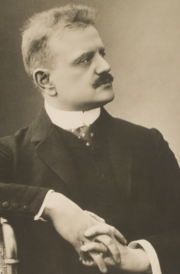|
The Captive Queen
The Captive Queen (in Finnish: Vapautettu kuningatar; sometimes translated to English as The Liberated Queen; subtitled "Cantata in Celebration of Snellman's Birth"), Op. 48, is a single-movement, patriotic cantata for mixed choir and orchestra written in 1906 by the Finnish composer Jean Sibelius. The piece, which is a setting of the Finnish author Paavo Cajander's Finnish-language poem of the same name, is chronologically the fifth of Sibelius's nine orchestral cantatas. The Captive Queen was first performed in Helsinki on 12 May 1906[a] by the Orchestra of Helsinki Philharmonic Society, conducted by the composer;[1] however, it premiered under the title "There Sings the Queen" ("Siell' laulavi kuningatar") in order to avoid the attention of the imperial censors.[3] Sibelius arranged the piece for male choir in 1910; this version was first performed on 28 November 1913 by the Choir of the Students' Union, with Heikki Klemetti conducting.[4] InstrumentationThe Captive Queen is scored for the following instruments and voices,[1] organized by family (vocalists, woodwinds, brass, percussion, and strings):
HistoryThe Finnish author Paavo Cajander (c. 1898) wrote the text for Sibelius's cantata The Captive Queen. A medal commemorating the 1906 centennial of Snellman's birth Sibelius composed the cantata for the centennial festivities that marked the birth (12 May 1806) of Johan Vilhelm Snellman,[5] a philosopher and statesman who was an important contributor to the Fennoman cause.[a] The Finnish composer Oskar Merikanto also contributed a new piece for the occasion, the Cantata in Memory of J. V. Snellman (Kantaatti J. V. Snellmanin muistolle, OM100; text by A. V. Koskimies). This premiered two hours before The Captive Queen, albeit at a different venue: the Finnish National Theatre.[6] DiscographyThe Finnish conductor Jorma Panula and the Helsinki Philharmonic Orchestra made the world premiere studio recording of The Captive Queen in September 1987 for Ondine; they were joined by a mixed choir credited as the "Academic Choir of Helsinki University" ("Helsingin Yliopiston Opettajankoulutuslaitoksen Kuoro").[2] Fabian Dahlström, in his 2003 catalogue of Sibelius works, however, connects this ensemble to Akateeminen Laulu,[2] which was founded in 1953 as the mixed choir of the Student Union of the University of Helsinki. The table below lists this and other commercially available recordings:
Notes, references, and sources
External links
|
|||||||||||||||||||||||||||||||||||||||||||||||||||||||||||||||||||||||||||


